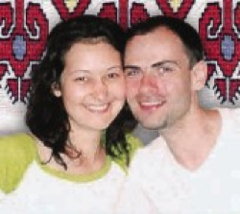|
Vesna Bajić and Saša Stojiljković
|
|
Vesna Bajić and Saša Stojiljković are from Belgrade (Beograd), Serbia. They have workshops about Serbian traditional dance, music, and song, and present an opportunity for amateurs of traditional music and dance from other countries to become familiar with the vast dance and musical heritage of Serbia. The preservation of dance and music heritage, based on expert teaching and its practical application, is the best way for traditonal dance and music to continue to live.
Vesna Bajić completed the five-year study of Ethnomusicology at the Faculty of Music in Belgrade. She is a collaborator of the Centre for the Study of the Folk Dances of Serbia and a pedagogue of traditional dance and music. She teaches traditional dancing from all the ethnochoreological regions of Serbia, playing on traditional flutes (svirala and dvojnice) and the accordion, and the singing of traditional songs. Her interests are also focused on preparing arrangements of traditional melodies for orchestras and choreographic or sets of traditional dances for Folklore ensembles.
Saša Stojiljković is a very gifted accordionist, playing traditional music of the South Slavic music culture. He gives musical accompaniment, lectures, and workshops in playing the accordion, and prepares arrangements of traditional melodies.
Vesna's and Saša's program for workshops is based on practical and theoretical explanations of traditional dances, songs, and instruments. Workshops are adapted to the different levels of Community groups and Folklore ensembles. These workshops and projects are designed to enhance the delivery of the curriculum in active, dynamic, and creative ways and to add to Community development through the arts of the rich Serbian traditional dance and music heritage.
An exciting combination of social dancing in the traditional round-shaped dance called kolo, singing, and playing on traditional instuments (svirala, dvojnice, and accordion), allows the group to learn together, to perform traditional step patterns, to sing while dancing, and dance with traditional musical accompaniment. Performing the heterogeneity of movements and styles of Serbian dances will supplement the motion of the body of a dancer with a new, technically different way.
Workshops include detailed work in learning traditional dances, music, and songs from Serbia. Daily work is organized in two to four hours for dancing and singing, and one to two hours for a workshop in learning to play traditional instruments.
All practical work is accompanied by the explanation of the dance and musical heritage and the customs of the Serbs. If the Community or Folkore ensemble has an orchestra or indivicual players, the work with them could be done in the preparation of arrangements. The selection of dances from different ethnochoreological regions of Serbia would build up a varied repertoire for the group and would give information about the basic characteristics of the dance patterns of Serbian dances. With these workshops, which embrace dancing, singing, and playing, the group can be prepared for performance. If there is an interest, theoretical lectures with video examples can also be organized.
Dances the couple has taught include Narodno oro, Pravo horo, and Vladino kolo.
